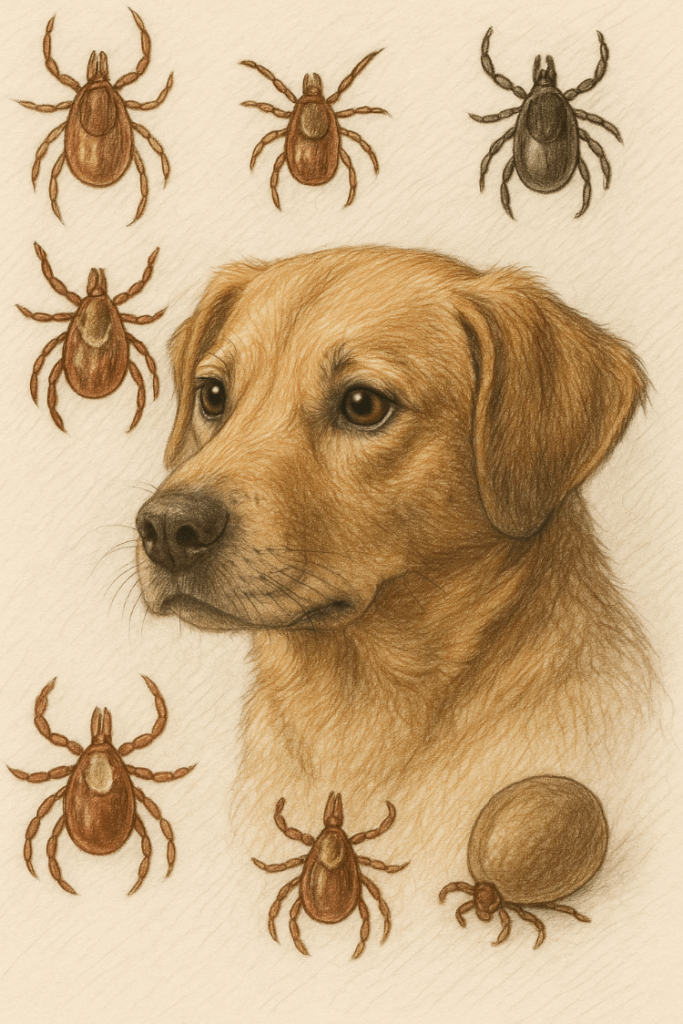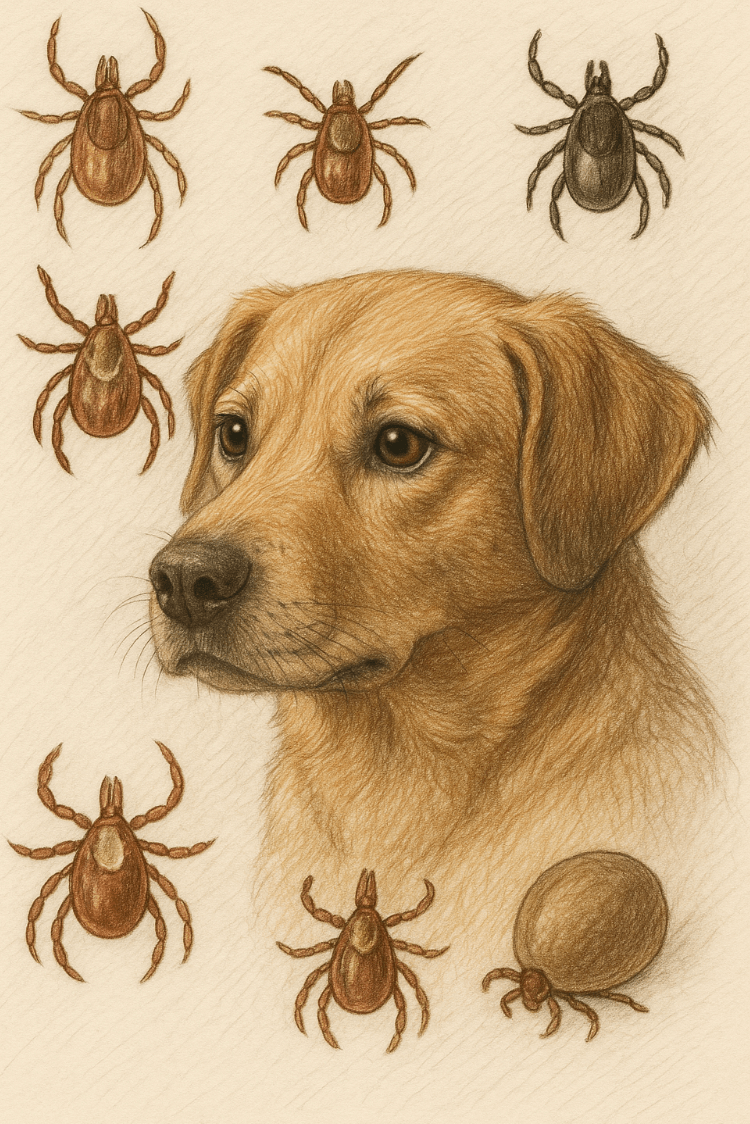Tick Diseases in Dogs: What Every Pet Owner Should Know
Ticks are more than just a nuisance—they can carry harmful diseases that pose serious risks to your dog’s health. As outdoor-loving pets, dogs are particularly vulnerable to tick bites, which can transmit infections like Lyme disease, ehrlichiosis, and anaplasmosis. Understanding these tick-borne illnesses is crucial for early detection and prevention. In this blog post, we’ll explore the most common tick diseases in dogs, their symptoms, treatment options, and practical tips to keep your furry friend safe. By staying informed, you can protect your dog from the dangers of ticks and ensure they live a happy, healthy life.
Expert Insight on Tick-Borne Diseases in Dogs
“Not all dogs with tick-borne diseases experience symptoms. Some dogs with strong immune systems are able to control the infection before symptoms develop. Young dogs, old dogs, and those with weakened immune systems may experience more severe disease.”
Common Tick-Borne Diseases in Dogs
Tick-borne diseases can vary in severity, but all require prompt attention to prevent complications. Here are some of the most prevalent tick diseases that affect dogs.
Lyme Disease:
Caused by the bacterium Borrelia burgdorferi, Lyme disease is transmitted through deer ticks and often leads to joint pain and fever.Ehrlichiosis:
This bacterial infection, spread by the brown dog tick, affects white blood cells and can cause lethargy, bruising, and weight loss.Anaplasmosis:
Transmitted by deer ticks and western black-legged ticks, anaplasmosis targets platelets and red blood cells, leading to lameness and bleeding disorders.Rocky Mountain Spotted Fever (RMSF):
Spread by the American dog tick, RMSF causes fever, neurological issues, and skin lesions if left untreated.Babesiosis:
This parasitic disease attacks red blood cells, resulting in anemia, jaundice, and weakness, often transmitted by certain tick species.
These diseases highlight the importance of vigilance when it comes to tick prevention and regular veterinary check-ups for your dog.

Symptoms of Tick Diseases in Dogs
Recognizing the signs of tick-borne diseases early can make a significant difference in your dog’s recovery. Keep an eye out for these common symptoms.
Fever and Lethargy:
A sudden spike in body temperature or unusual tiredness can indicate a tick-borne infection.Joint Pain and Lameness:
Stiffness, swelling, or difficulty moving may signal conditions like Lyme disease or anaplasmosis.Loss of Appetite:
Dogs with tick diseases often lose interest in food, leading to weight loss and weakness.Bruising or Bleeding:
Unexplained bruising, nosebleeds, or blood in urine or stool can point to clotting disorders caused by ehrlichiosis or anaplasmosis.Neurological Issues:
Seizures, confusion, or unsteady gait may occur in advanced cases of diseases like RMSF or babesiosis.
If you notice any of these symptoms, consult your veterinarian immediately to rule out or treat tick-related illnesses.
Check this guide 👉Dog Ticks in the House: Best 7 Expert Tips!
Check this guide 👉American Dog Tick Dermacentor variabilis: Best 7 Tips!
Check this guide 👉White Ticks on Dogs: Best 7 Expert Tips!
Prevention Tips for Tick Diseases | Signs It’s Time to Visit the Vet |
|---|---|
Use vet-recommended tick prevention products | Persistent fever or lethargy |
Check your dog for ticks after outdoor activities | Sudden lameness or joint swelling |
Keep your yard free of tall grass and debris | Loss of appetite or significant weight loss |
Schedule regular vet check-ups for early detection | Unexplained bruising or bleeding |
Avoid walking your dog in wooded or tick-infested areas | Neurological symptoms like seizures |
Treatment Options for Tick Diseases in Dogs
While tick-borne diseases can be serious, many are treatable with timely intervention. Here are some common approaches veterinarians use to manage these conditions.
Antibiotics:
Most bacterial tick diseases, such as Lyme disease and ehrlichiosis, are treated with antibiotics like doxycycline or amoxicillin.Pain Management:
Anti-inflammatory medications may be prescribed to alleviate joint pain and discomfort associated with tick diseases.Supportive Care:
Intravenous fluids and nutritional support can help dogs recover from severe cases of dehydration or anemia.Blood Transfusions:
In cases of extreme blood loss or anemia caused by babesiosis, blood transfusions may be necessary.Follow-Up Monitoring:
Regular vet visits are essential to monitor your dog’s progress and ensure the infection has been fully eradicated.
With proper treatment and care, most dogs can recover from tick diseases and return to their playful selves.
Preventing Tick Diseases in Dogs
Prevention is always better than cure when it comes to tick-borne illnesses. These proactive measures can significantly reduce your dog’s risk of exposure.
Use Tick Preventatives:
Apply topical treatments, collars, or oral medications recommended by your vet to repel and kill ticks.Inspect Your Dog Regularly:
After walks or outdoor play, thoroughly check your dog’s fur, ears, and paws for ticks and remove them promptly.Maintain a Tick-Free Yard:
Mow your lawn regularly, remove leaf litter, and use pet-safe insecticides to deter ticks from your property.Avoid High-Risk Areas:
Steer clear of wooded trails, tall grass, and areas known to have heavy tick populations.Groom Your Dog Frequently:
Regular brushing not only keeps your dog’s coat healthy but also helps you spot ticks early before they attach.
By taking these steps, you can minimize your dog’s exposure to ticks and the diseases they carry.
Natural Ways to Repel Ticks from Dogs
For pet owners seeking natural alternatives to chemical preventatives, there are several ways to repel ticks without compromising your dog’s health.
Essential Oils:
Diluted oils like cedarwood, lavender, and rosemary can act as natural repellents when applied to your dog’s collar or bedding.Apple Cider Vinegar Spray:
Mix apple cider vinegar with water and spray it lightly on your dog’s coat to deter ticks.Diatomaceous Earth:
This non-toxic powder can be sprinkled in your home and yard to kill ticks and other pests naturally.Herbal Supplements:
Garlic (in small amounts) and brewer’s yeast supplements may help make your dog less appealing to ticks.Regular Grooming with Natural Shampoos:
Use shampoos containing neem oil or other natural ingredients to clean and protect your dog’s skin.
While natural methods can help, always consult your vet before trying new remedies to ensure safety.
Seasonal Risks of Tick Exposure
Ticks thrive in specific weather conditions, making certain seasons more hazardous for dogs. Understanding these patterns helps you stay prepared.
Spring and Summer:
Warm temperatures and increased outdoor activity create ideal conditions for ticks to flourish.Fall:
Ticks remain active in cooler weather, especially in wooded areas where leaves provide shelter.Winter:
While ticks are less active in cold climates, they can still survive in protected environments like sheds or garages.Rainy Seasons:
Moisture attracts ticks, so be extra cautious after rainfall or in humid regions.Urban vs. Rural Risks:
Ticks are more common in rural areas, but urban parks and green spaces can also harbor these pests.
Knowing when ticks are most active allows you to adjust your prevention strategies accordingly.
The Role of Vaccines in Preventing Tick Diseases
Vaccination plays a vital role in protecting dogs from certain tick-borne illnesses. Here’s what you need to know about available vaccines.
Lyme Disease Vaccine:
The Lyme vaccine is highly effective for dogs living in areas with high deer tick populations.Vaccine Limitations:
Not all tick diseases have vaccines, so preventive measures remain essential even for vaccinated dogs.Booster Shots:
Regular boosters are required to maintain immunity, so schedule annual vet visits for updates.Consultation with Your Vet:
Discuss your dog’s lifestyle and risk factors with your vet to determine if vaccination is appropriate.Combining Vaccines with Prevention:
Vaccines work best when paired with tick preventatives and regular monitoring for optimal protection.
Vaccines are a powerful tool in the fight against tick diseases, but they’re just one piece of the puzzle.
Frequently Asked Questions About Tick Diseases in Dogs
How do I know if my dog has a tick-borne disease?
Look for symptoms like fever, lethargy, lameness, or bruising, and consult your vet for diagnostic testing.
Can indoor dogs get tick diseases?
Yes, ticks can hitchhike indoors on clothing or other pets, so even indoor dogs need protection.
Are tick diseases contagious to humans?
While humans can contract tick diseases, they cannot catch them directly from dogs—only from tick bites.
How long does it take for a tick to transmit disease?
Ticks typically need to be attached for 24-48 hours to transmit pathogens, so prompt removal is critical.
What should I do if I find a tick on my dog?
Use tweezers or a tick removal tool to carefully grasp the tick close to the skin and pull it straight out.
Protecting Your Dog from Tick Diseases
Tick diseases in dogs are a serious concern, but with awareness and prevention, you can keep your loyal companion safe. Regular tick checks, preventive treatments, and prompt veterinary care are key to avoiding the potentially devastating effects of tick-borne illnesses. By staying vigilant and informed, you can ensure your dog enjoys a long, healthy, and tick-free life. Remember, your dog relies on you to safeguard their well-being—so take the necessary steps to protect them from these tiny but dangerous pests.
Cat Fever Treatment: Best 7 Expert Tips! Discover expert advice on identifying, managing, and treating fever in cats to ensure their quick recovery and well-being.
Understanding Meloxicam for Cats: Best 7 Expert Tips! Learn how to safely administer meloxicam, manage side effects, and ensure your cat's comfort with expert advice on feline pain relief.
Amoxicillin for Cat UTI: Best 7 Expert Tips! Discover safe usage, dosage guidelines, and expert advice on treating feline urinary tract infections effectively with amoxicillin.
Understanding Cat Cancer Treatment: Best 7 Expert Tips! Discover expert advice on managing feline cancer, from early detection to treatment options, ensuring your cat’s health and comfort.





